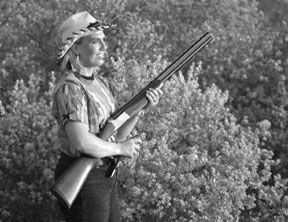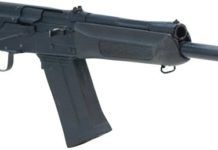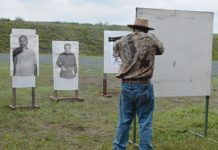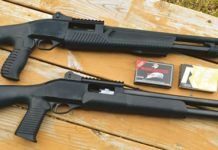
The best place to field-test any shotgun is on live birds, but because so much of our testing is done out of season, we only infrequently get to pop a cap at the real thing. However, we recently got to test two inexpensive over/unders on high-flying whitewing and mourning doves in Uvalde, Texas, and we came away with what we believe are some valuable real-world insights into the performance of these two guns.
The first gun was the $450 Lanber Model 2087 12 gauge, available from CDNN, (800) 588-9500 or (www.cdnninvestments.com). This gun had 28-inch stacked tubes and 3-inch chambers, a walnut stock, and five choke tubes. Also from CDNN, we found a Tristar Silver II for $490. This gun was likewise configured as a 28/3-inch, and it came with three chokes.
We toted both guns into a field just north of Uvalde and pass-shot at very high-flying doves, and a few others easier to hit, until our shoulders hurt. Along the way, we learned a lot about both guns in an unstructured setting, where a single mismount with a gun loaded with a 3-inch magnum hurts for days. Here’s what we found:
Lanber Model 2087 12 Gauge, $450
Lanber Shotguns are imported by ITC International, Inc., 1720 Cumberland Point Dr., Suite 5, Marietta, GA 30067 (770) 858-0048. The company’s guns, manufactured in Spain, range in price from $850 to $1,250 MSRP. Obviously, we got ours at a much reduced rate.
Among the company’s over/under shotguns are the Model 2065 (20 gauge), 2070 (a 2.75-inch chamber 26-inch-barrel gun), 2081 (12/28/2.75 configuration), 2082 (comes in a 12/30 version), 2084 (fixed choke 12 gauge), 2085 (fixed choke 30-incher), and our gun, the 2087. There’s also a separate line of semi-autos.
Our gun came with five Lanber choke tubes and a wrench, all packaged in a plastic case. The chokes were Full, Improved Modified, Modified, Improved Cylinder, and Cylinder. The 2087 featured a 3-inch chamber, ventilated-rib barrel, walnut buttstock and forearm, blued-metal finish, and a red-bead front sight.
It was hard to see where Lanber had shaved features to save money on the gun. At the pistol grip, the nicely figured wood stock had pressed checkering, but it did help the shooter’s grip. The fit at the buttpad was tight, and the top of the rubber was chamfered for easier mounting. The red-rubber pad wasn’t all that soft, but we’ve seen worse. The Schnabel forend was gracefully cut, with plenty of checkering. The wood grain underneath was also adequate, in our view.
The trigger guard was blued metal with scrollwork engraving, which complemented a similar pattern on the matte-stainless receiver. The metalwork was fine overall, with deep, flawless bluing on the steel. The ventilated rib was machined evenly down its length. It measured 7mm in width. The red front-sight bead was very eye catching, and it took real effort to look past it and focus on the birds. Our Lanber had dual ejectors that didn’t always remove hot shells from the chambers.
The gun measured 44.5 inches overall, with a 14.4-inch length of pull. It weighed 7 pounds unloaded. We thought the trigger was heavy, breaking at 7.5 pounds for the top barrel and 6 pounds for the bottom barrel. Moreover, this significant difference in pull weight meant that the shooter’s timing could be thrown off. Moreover, the break was sloppy on both parts of the single-selective trigger action.
The biggest difference between these two closely matched guns was in how they pointed. The Lanber had more pitch in its buttstock; that is, more drop in the angle of the buttstock relative to the sight plane. For some of our shooters used to shooting straighter stocks, that meant the gun tended to mount low, and with some of the loads we were shooting, that was the kick of death.
Also, on the high-flying birds we saw so much of, we tended to see too much of the rib, which meant we shot behind the 40-mph doves (which was easy enough to do anyway).
Otherwise, the gun was balanced well, with the weight seeming to fall between the shooter’s hands. The tang safety reset when the barrels opened, and the barrel-selector switch operated smoothly and positively. We liked the angle of the grip in relation to the trigger.
Tristar Silver II 12 Gauge TRI-32128, $490
The Silver Series guns are imported by Tristar Sporting Arms, Ltd., P.O. Box 7496, 1814-16 Linn, North Kansas City, MO 64116; (816) 421-1400, (tristar@blitz-it.net). They’re manufactured by Zabala in Spain. These over/unders have solid frames with sealed actions and self-adjusting locking bolts, single selective triggers, and steel mono-block barrel construction. They also come with three interchangeable chokes (IC/M/F) and auto-selective ejectors, and are available in 12-, 16-, and 20-gauge models. We tested the 12/28/3 configuration.
Like with the Lanber choke tubes, the Silver II’s wrench and tubes came packaged in a plastic button-closure case. The II featured a 3-inch chamber, ventilated-rib barrel, walnut buttstock and forearm, blued-metal finish, and a gold-bead front sight. The trigger was gold-colored, in contrast to the black trigger on the Lanber.
The Silver’s pistol grip and buttstock has less figured wood, and the pressed checkering was broken along several of the edges. The fit at the buttpad was tight, but the top of the rubber had not been ground for easier mounting. The black-rubber pad offered about the same cushioning as the Lanber, we thought. The beavertail forend was thick and lacked the eye-pleasing lines of the Lanber, in our view, and the wood grain was plain, in our estimation.
The trigger guard was stainless with scrollwork on the bottom, and the stainless receiver also featured scrollwork and a game scene on each sideplate. The bluing was fine. The ventilated rib was machined evenly and its nonglare pattern was more effective at killing sunlight, we thought. It, too, measured 7mm in width. The gold front-sight bead wasn’t as distracting to our eyes. During our shooting, the Silver II’s dual ejectors kicked out hot shells better than the Lanber.
The gun measured 45 inches in overall length, with a 14.5-inch length of pull. It weighed 6.9 pounds unloaded. The II’s trigger pulls weren’t great, but they were better than the Lanber’s, breaking at 6.6 pounds for the top barrel and 6.5 pounds for the bottom barrel. This slight difference in pull weight improved shot-to-shot timing, and they broke more cleanly to boot.
As we noted earlier, the Lanber had more pitch in its stock, and we didn’t much like that. The straighter stock on the II showed us the top of the rib nearly every time, and more hook in the grip angle offered a very positive grasp on the stock. This gun balanced at the hinge, right where we like it.
Gun Tests Recommends
Lanber Model 2087 12 Gauge, $450. Conditional Buy. Nothing so wrong here that we wouldn’t consider this gun for the money. If you handle this gun, the crucial spot to check is how the gun meets your face. If that feels right after a few dozen mounts, then reach for your wallet.
Tristar Silver II 12 Gauge TRI-32128, $490. Our Pick. For $500, this was a lot of gun. Other than cosmetically, we think it would fare very well against guns costing twice as much.
———-
For information on Uvalde, Texas, dove hunting, contact Kimbra Pierce at the Uvalde Convention & Visitors Bureau, (830) 278-4115; or Browder Graves at Frio Country Ranches, (830) 279-0942.




























